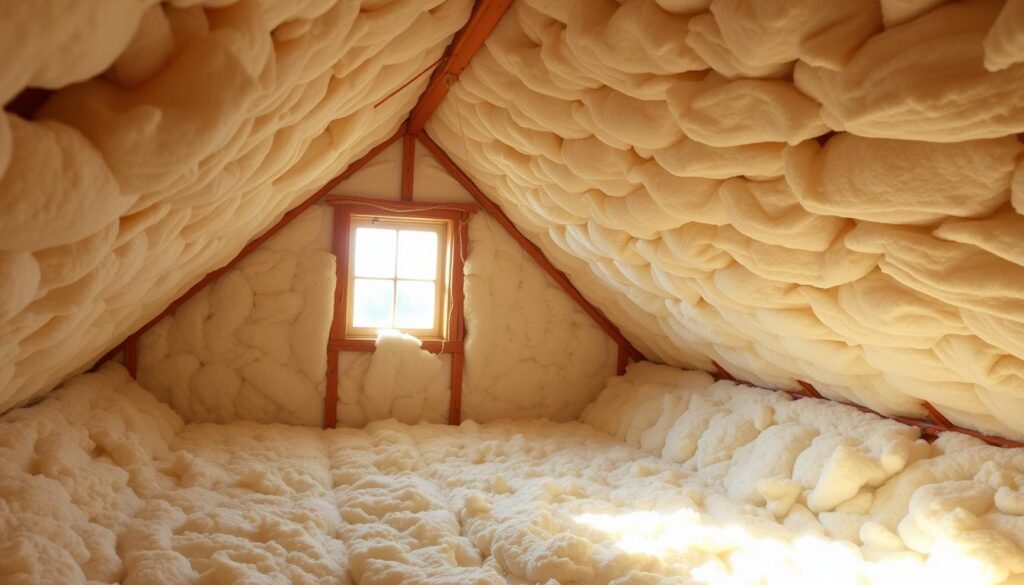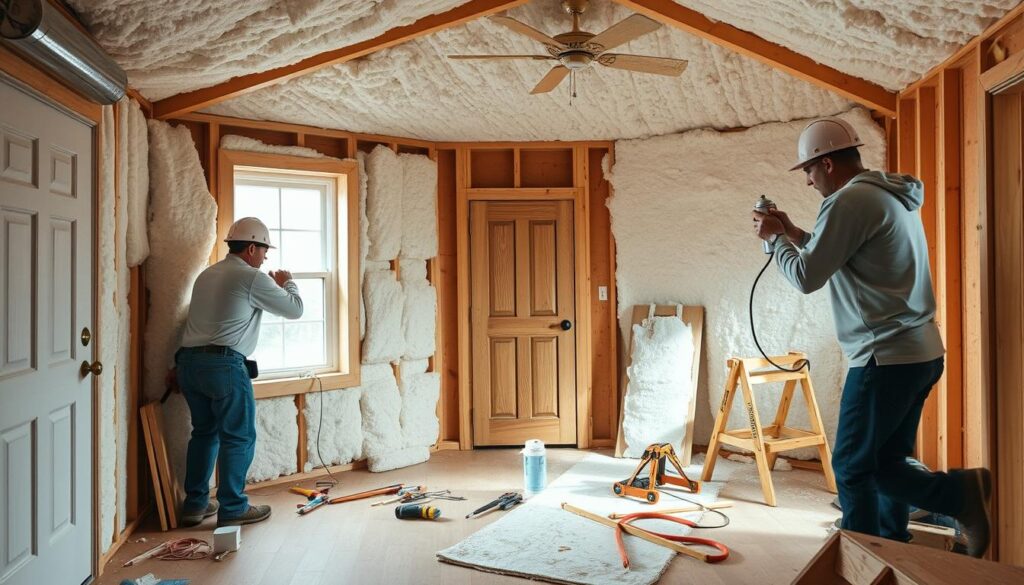Choosing the right insulation for your home is key. It affects your energy use, comfort, and bills. This guide will cover the basics of insulation, the types available, and why R-value matters. We’ll also look at what to consider when picking the best insulation for your home.
Good insulation keeps your home comfy and energy-efficient all year. Knowing the basics and what your home needs helps you make a smart choice. This choice will save you money and improve your home’s value over time.
Understanding Home Insulation Basics
Proper home insulation keeps your home comfy and saves on energy bills. It’s key to know the basics to choose the right insulation. This section will cover insulation types, R-value, and important terms to guide you.
Types of Insulation Materials
Fiberglass, cellulose, and spray foam are common insulation materials. Fiberglass is affordable and easy to install. Cellulose, made from recycled stuff, is eco-friendly and has great thermal resistance. Spray foam is top-notch for sealing air.
R-Value and Its Importance
The R-value shows how well insulation blocks heat. A higher R-value means better thermal resistance. Picking the right R-value is key for a comfy home and lower energy bills.
Key Insulation Terms to Know
- Thermal bridging: Heat flows through materials like wall studs, bypassing insulation.
- Vapor barrier: Stops moisture from getting into or out of insulation, preventing mold and damage.
- Air sealing: Seals gaps and cracks to stop air leaks and boost energy efficiency.
Knowing these basics helps you pick and install the best insulation for your home.
Benefits of Proper Home Insulation
Investing in quality home insulation brings many benefits. It makes your home more comfortable and sustainable. You’ll save energy, enjoy better comfort, and have less noise and moisture.
One big plus is energy savings. Insulation keeps your home at a steady temperature. This means your heating and cooling systems work less, saving you money on bills and reducing your carbon footprint.
Insulation also makes your home more comfortable. It keeps the temperature even and blocks drafts. This makes your home cozy and relaxing all year.
Another great thing about insulation is how it reduces noise. It acts as a sound barrier, blocking out traffic, neighbors, and even rain. This makes your home quieter and more peaceful.
Insulation also helps control moisture. It stops too much humidity and prevents mold and mildew. This keeps your home dry and healthy, protecting your family’s well-being.
In the end, good insulation does more than save energy. It also improves comfort, reduces noise, and controls moisture. These benefits make your home a better place to live, for you and your family.
| Benefit | Description |
|---|---|
| Energy Savings | Reduced energy consumption and lower utility bills |
| Comfort | Consistent indoor temperature and reduced drafts |
| Noise Reduction | Improved sound absorption and dampening of external noises |
| Moisture Control | Regulation of humidity levels and prevention of mold/mildew |
Factors Affecting Your Insulation Choice
Choosing the right insulation for your home involves several important factors. The climate and weather in your area are key. So is your home’s structure and design, and your budget. Each of these elements helps decide the best insulation for you.
Climate and Weather Conditions
The regional climate and weather patterns affect insulation needs. In cold areas, you might need insulation with a higher R-value to keep warm and save on energy. In warmer places, insulation helps control temperature and cuts down on air conditioning costs.
Home Structure and Design
The age and design of your home matter too. Older homes often need more insulation to be energy-efficient. Your home’s unique features and layout might also require special insulation for areas like attics, walls, or crawl spaces.
Budget Considerations
Your budget for insulation is also important. While better insulation saves money in the long run, the upfront renovation costs can be high. Finding a balance between cost and energy savings is crucial when picking insulation.
By thinking about these factors, you can make a smart choice. You’ll find insulation that fits your home’s needs, climate, and budget.
Different Areas Requiring Insulation in Your Home
Home insulation is key to keeping your home comfortable. Each part of your home, from the attic to the basement, needs its own type of insulation. This affects how well your home uses energy and how comfortable it feels.
Attic Insulation
The attic is a top priority for attic insulation. Heat goes up, and a well-insulated attic saves energy. It keeps your home warm in winter and cool in summer. Good attic insulation means a cozy home and lower energy bills.
Wall Insulation
Wall insulation is vital for keeping your home’s temperature right. It stops heat from moving in or out. This makes your home more energy-efficient and comfortable.
Basement and Crawl Space Insulation
Don’t forget about the basement and crawl space. They can lose or gain a lot of heat. Proper basement insulation and crawl space insulation keep your home’s temperature steady. They also prevent moisture problems that can harm your home.
| Insulation Area | Importance | Recommended Insulation Type |
|---|---|---|
| Attic | Helps prevent heat loss/gain, improving energy efficiency | Blown-in cellulose, fiberglass, or spray foam |
| Walls | Regulates temperature, enhances comfort and energy savings | Fiberglass batts, rigid foam boards, or spray foam |
| Basement/Crawl Space | Prevents moisture issues and maintains overall home temperature | Rigid foam boards or spray foam |
Insulating these key areas improves your home’s energy use, comfort, and can cut utility costs. Investing in insulation is a smart move for your home’s performance and your family’s health.

Guide to Choosing Home Insulation
Choosing the right insulation for your home is key. It affects both how well your home stays warm or cool and how much it costs. We’ll look at different insulation types, their prices, and what you need to install them.
Material Comparison
Fiberglass, cellulose, spray foam, and rigid foam boards are common insulations. Each has its own strengths, like how well they keep heat in or out, block sound, and handle moisture. For example, fiberglass and cellulose are cheaper, but spray foam and rigid foam insulate better.
Cost Analysis
The cost of insulation varies a lot. It depends on the R-value, how it’s installed, and where you live. Fiberglass and cellulose are cheaper, but spray foam and rigid foam cost more upfront. Yet, they can save you money on energy in the long run.
Installation Requirements
How easy it is to install insulation matters too. Fiberglass and cellulose can be put in by homeowners. But, spray foam and rigid foam need a pro for the best results. Knowing what each type needs helps you choose based on your DIY skills and schedule.
By looking at insulation’s performance, cost, and how to install it, you can pick the best for your home. The right insulation makes your home cozy, saves energy, and helps the planet.
Professional vs DIY Installation
Homeowners often face a big choice: should they hire pros for insulation or do it themselves? Each option has its own good points and things to think about.
Hiring Insulation Contractors
Choosing insulation contractors can be a smart move. They bring skills and tools to get the job done right. They know how to handle tricky spots like attics and walls, reducing the chance of mistakes.
The DIY Insulation Option
For those up for a challenge, DIY insulation projects can save money. Doing it yourself can also teach you about your home’s insulation. But, it needs careful planning and a lot of effort to do well.
| Consideration | Professional Installation | DIY Installation |
|---|---|---|
| Expertise | Experienced insulation contractors have the knowledge and skills to ensure proper installation. | Homeowners may lack the specialized expertise required for complex installations. |
| Cost | The labor and expertise of professional installers may come at a higher upfront cost. | DIY projects can potentially save on installation costs, but require a significant time investment. |
| Quality Assurance | Professional contractors follow industry standards and provide warranties, ensuring the insulation’s long-term performance. | DIY installations may be more prone to errors, potentially compromising the insulation’s effectiveness. |
| Time and Effort | Professional installers can complete the project more efficiently, saving homeowners time and effort. | DIY projects demand a significant time commitment from homeowners, who must also have the necessary tools and skills. |
The choice between insulation contractors and DIY insulation project depends on your budget, skills, and time. Weighing the good and bad of each can help you decide what’s best for your home.

Common Insulation Mistakes to Avoid
Proper home insulation is key for energy savings, comfort, and a healthy home. Yet, many homeowners make mistakes that hurt their insulation’s performance. Knowing and avoiding these common errors can help your insulation work right.
Installation Errors
One big mistake is bad installation. This can cause air leaks and poor heat control. To fix this, always follow the manufacturer’s guide and get a professional to install it right.
Material Selection Mistakes
Choosing the wrong insulation can also be a problem. If you pick one with a low R-value, you might face insulation gaps and less energy savings. On the other hand, spending too much on insulation you don’t need is a waste.
Ventilation Oversights
Not enough ventilation in your attic or walls can cause moisture problems. Good ventilation helps control temperature, stops air leaks, and keeps your attic ventilation in check. These are all crucial for your insulation’s long-term success.
By watching out for these common mistakes and fixing them, you can make sure your insulation works well. This will give you the comfort and energy savings you want.
Energy Savings and ROI
Investing in proper home insulation offers big long-term benefits. It helps keep your home at a steady temperature. This means your heating and cooling systems work less, saving you money on bills.
The insulation payback period is key to consider. It shows how long it takes for insulation costs to be covered by energy savings. This time varies based on insulation type, climate, and home design.
| Insulation Type | Average Payback Period | Energy Savings Potential |
|---|---|---|
| Fiberglass | 5-10 years | 20-30% reduction in utility bills |
| Spray Foam | 3-7 years | 30-50% reduction in utility bills |
| Cellulose | 6-12 years | 25-35% reduction in utility bills |
Insulation also boosts your home’s value. This makes it a smart investment for both now and later.
“Insulation is one of the most cost-effective ways to improve the energy efficiency of your home and lower your utility bills.”
Choosing the right insulation and ensuring it’s installed correctly is crucial. This way, homeowners can boost their energy efficiency, cut down on utility bills, and enjoy a good insulation payback period.
Environmental Impact of Different Insulation Types
Homeowners are now looking for eco-friendly solutions. It’s key to know how different insulation materials affect the environment. From green insulation to the sustainability factors of various products, understanding their environmental impact helps make better choices.
Eco-Friendly Options
Many are turning to recycled materials for insulation. Options like recycled denim, cellulose, and mineral wool are great. They offer good thermal performance and help reduce waste and carbon footprint.
These eco-friendly solutions help homeowners support a sustainable future.
Sustainability Factors
The embodied energy of insulation is also important. Embodied energy is the energy needed to make, transport, and install insulation. Choosing insulation with less embodied energy reduces environmental impact.
By looking at the sustainability of different insulation types, homeowners can choose what’s best for the planet.
FAQ
What are the different types of insulation materials?
Common insulation materials include fiberglass, cellulose, and spray foam. You also have rigid foam and mineral wool. Each has its own R-value and installation needs.
How do I determine the right R-value for my home?
The right R-value depends on your local climate and the area you’re insulating. It also depends on your energy goals. Check the Department of Energy’s guidelines or talk to a pro for the best R-value for you.
What are the key benefits of proper home insulation?
Good insulation saves energy, makes your home more comfortable, and reduces noise. It also controls moisture and makes your home more eco-friendly.
What factors should I consider when choosing insulation for my home?
Think about your local climate, your home’s design, and your budget. Also, consider the insulation needs of different areas like the attic and walls.
Should I hire a professional for insulation installation or do it myself?
Whether to hire a pro or DIY depends on the job’s complexity and your skills. Professional installation ensures quality, but DIY can save money if you’re skilled.
What are some common insulation mistakes to avoid?
Avoid mistakes like wrong installation, choosing the wrong material, and forgetting about ventilation. Plan well and pay attention to details to avoid these errors.
How can I maximize energy savings and the return on investment (ROI) from insulation?
Good insulation saves energy and can give a good ROI. The type of insulation, your climate, and your home’s efficiency all affect savings and payback time.
What are the most environmentally-friendly insulation options?
Eco-friendly options include recycled cellulose and natural fibers like wool. Insulation made from renewable or recycled materials also has a lower carbon footprint, making your home more sustainable.


